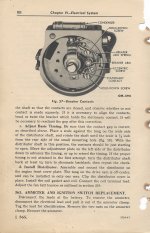My 1947 2N was running great after new carb, distributer, plugs and wires, coil, and cleaning out gas tank and filters. I have very good gas flow thru carb. I changed oil and added sea foam to fuel tank for winter and plugged in a battery maintainer.
My issue: I started up tractor, purred like a kitten for a couple minutes, then started running as if the tractor was running on half cylinders, after a minute or so it started purring like a kitten again then started running bad again. Same cycle! I pulled plugs and they are completely fouled. I will replace plugs to see what happens but my questions is how plugs fouled? I ran tractor off and on in summer and it ran beautiful. My tractor was converted to 12v system by previous owner. I've owned it less than a year, so my question is, can a voltage regulator cause my problem? How can I test my voltage regulator? I will be testing battery voltage with a tester while running tractor after I change the plugs today but I cant figure out why this suddenly happened. Any incites? Can it be the voltage regulator and how can I know for sure if it is? I'm not a certified mechanic and don't understand the connection between the voltage regulator and firing sequence but I'm open to advice. Does the voltage regulator feed constant voltage to distributer, points, etc.. ? As you can tell, im obviosly not a mechanic. Please advise! Thanks
Your 2N never had a Voltage Regulator. though some 9N/2N owners revamped their electricals to the 8N GEN and VR later upon the 8N release, but this was never a factory option. ALL FORDs used the 6V/POS GRN electrical system. Except for the first, early 9N 1939 Tractor til March, 1940, ALL 9N and 2N Models never used a VOLTAGE RGULATOR with the GENERATOR. The first, 9N-10000-A GEN used a VR as it had the "B" Circuit Design, was a 2-Wire/2-Brush 7-AMP unit, After 1940 the GEN was changed to a 1-Wire/3-Brush, 7-AMP, "A" Circuit Design unit and now used the ROUNDCAN CUTOUT CIRCUIT. It was soon replaced by a larger11.5 AMP unit, still a 1-WIRE/3-BRUSH and this version was used all the way thru 9N/2N Production. In 1947 with the release of the new 8N Model, the charging system was revamped to a 3-Wire/3*-Brush, 11.5 AMP, "A" Circuit Design Unit and now used a VOLTAGE REGULATOR. It would soon be replaced by a 3-WIRE/2-BRUSH, 20 AMP unit and this was used up thru all Hundred Series Models as well. In the late 1950's FORD introduced the diesel models and they now used a 12-VOLT power source but were still POSITIVE GROUND and required a VOLTAGE REGULATOR as well. Except for the FORD 2N Warhorse Model that had no electrics, only used a Magneto, all 9N and 2N Models used a 1-Wire Starter Motor with NO RELAY (SOLENOID).
If'N ya wanna do this right, I advise: STOP buying new parts and replacing them willy-nilly. Perform the FUEL FLOW test and if it passes, leave it alone. Pull spark plugs and if fouled clean and recheck the gap, then reinstall. Leave them alone. NOW, with power source/battery disconnected, go thru the entire wiring setup per sketches and manuals. FACT: 99.98% of all non-starting issue are due to incorrect wiring regardless if using the OEM 6V/POS GRN or a 12-V conversion. Use a VOM set to Continuity not an idiot test light. Don't rely in what the wire colors are, not a good method, and most likely not as they were originally. It may be time to invest in a new wiring harness now anyway. You can motor/bench test the GEN and STARTER MOTOR or take to a local shop to be tested. If all pass inspection, can reinstall units. Next, and this is the most critical factor, is the notorious Front Mount Distributor. It is the #1 most misunderstood feature on these old FORDs. It is tuned and timed off the tractor on your work bench and uses no timing light. Your ESSENTIAL MANUALS all have chapters on the setting instructions. When tuned, timed, and tested, mounting the unit back on the tractor engine is most important. The engine Camshaft Face has a female offset slot on it. The Distributor Cam & Weights have a male offset tang on it and both must mate up properly at assembly. Failure will result in a broken aluminum base on the unit at first power and render it junk.
There is a lot more to the electrical system than whether if it is 6V or 12V. ALL Front Mount Distributors use the 9N-12250 Ballast Resistor in the Coil Circuit with both the 6V or 12V setup. ALL 9N/Ns use the 9N-10505-B Round Can Cutout after 1940. All units used the 9N-10850-B 30-AMP Loop AMMETER. After distributor has been tuned/rebuilt and tested on the bench, it is ready to mount. Use the STANDARD IGNTION/BLUE STREAK POINTS, p/n FD-6967X, available at NAPA. You will perform final testing when all wiring is verified correct and before turning over engine. I can post instructions one you get that far. When all is done properly and all test pass, tractor will start. Final advice is to always use a fan belt tensioning device with the GEN or ALT otherwise you will never charge the battery.







